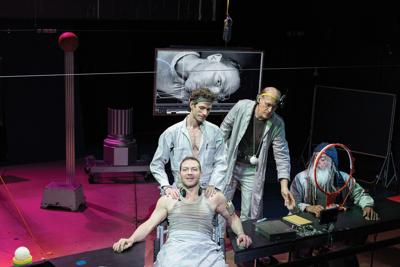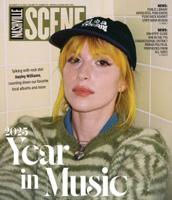In the early days of their new production of Richard Foreman’s Symphony of Rats — which arrives at OZ Arts this weekend — the visionary avant-garde artists of The Wooster Group ran into a momentary snag. The fabric used in Antonia Belt’s fabulous costumes was conducting electricity, thereby interfering with the performers’ microphones and receivers.
“We suddenly realized that the guys wouldn’t be able to wear their microphones on their bodies,” explains Kate Valk, a founding member of the esteemed ensemble who is currently co-directing Symphony with The Wooster Group’s fearless leader, Elizabeth LeCompte. “At first, we were like, ‘Oh my God — you mean they’ve got to wear everything on their heads like some sort of weird antennae?’ But then it was, ‘Hold on. You know, that’s not half-bad.’ And that’s actually a good example of how we work — and also what makes it so much fun.”
That kind of creative, outside-the-box thinking has been a hallmark of The Wooster Group since it was established in the mid-1970s. Employing a uniquely collaborative process — with a focus on experimentation and the melding of art forms — the group’s work is often defined by its daring use of lighting, sound and video technologies. And unlike more traditional theater companies, the group incorporates such elements throughout the rehearsal process, rather than introducing them during a final tech week.
“A lot of people have to manufacture theater on a three- to six-week schedule,” Valk says. “They learn the lines, do the blocking, and then all the tech and costumes come in at the end. For us, the technical artists — the sound, video, lights — they’re all integral to our rehearsals from the very beginning. That allows us to develop a specific language, a vocabulary for the piece. And it’s the same with costumes. We don’t even have a rehearsal unless the performers are fully garbed. It defines the look, the lighting and the movement. It’s a huge part of the process.”
Also key to the development of Symphony of Rats was a “reimagining” of Richard Foreman’s original text.
Penned by the avant-garde playwright during the Reagan administration, Symphony offers a sharp political satire concerning a U.S. president who may (or may not) be receiving messages from outer space. It was originally produced by Foreman’s Ontological-Hysteric Theater and The Wooster Group in 1988, with Foreman directing.
Word has it that when LeCompte and Valk asked Foreman if the group could make a new version of the play, he said: “You can do whatever you want! I hope it’s completely unrecognizable.”
And by all accounts, it truly is — with the group’s new interpretation featuring iambic pentameter, along with original music by Suzzy Roche.
“I love Richard’s writing,” says Valk, who performed in the original 1988 production. “I don’t really know what it means, but I love it because it’s so open and determinedly anti-narrative. But Liz is always looking for a story, so we had a good push-pull going at first, as we figured out how to approach the text. What she decided, which I think was very definitive, was that she wanted to set the entire thing to music. It is a symphony of rats, after all. And to do that, we needed to lift the language. So we put it into meter — iambic pentameter — and that just lifted everything.”
LeCompte agrees, noting that the choice “opened the door to the imagination.”
“I really did sort of detest the writing at first, until we were able to put it into verse,” she says with a laugh. “But then I understood it. I could hear it as an opera. I could understand it in a more poetic way. Before, it had always been done with a kind of naturalism. And natural performance mixed with this poetic text was very confusing to me. I felt it should be bigger than that. I wanted to show it, to expose it with a kind of irony and a sense of humor.”
For Mark Murphy, executive and artistic director of OZ Arts, Symphony offers “a multilayered concoction of live performance” that is “remarkably visceral and cinematic.”
“There’s so much happening in terms of all the imagery, the multimedia components, the music and movement and humor,” says Murphy. “Of course, when you talk about something being so complex and multilayered, it begins to sound rather serious and even academic. But the truth is it’s also very funny. It’s a wild, kinetic experience.
“It’s hard to imagine a more important, influential group in the world of contemporary performing arts,” Murphy adds, noting that Symphony marks his 16th time presenting a Wooster Group production. “I’m a huge fan, and I’m simply thrilled to be able to introduce them to our Nashville audiences. They’ve been at it since the mid-’70s, and they’re still on the cutting edge — leading the way and rewriting the rules.”





